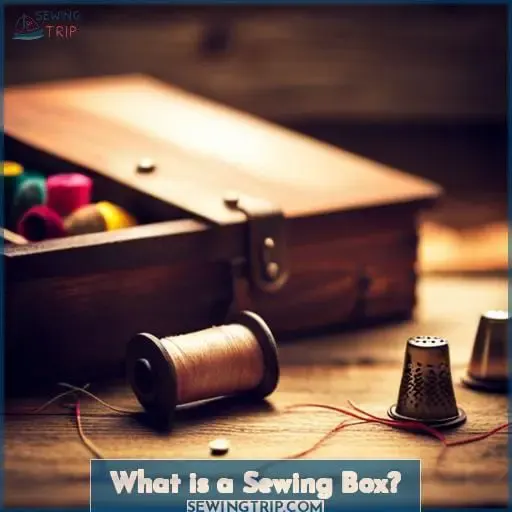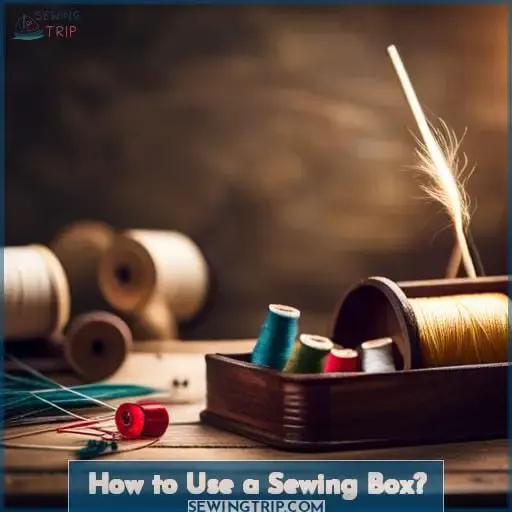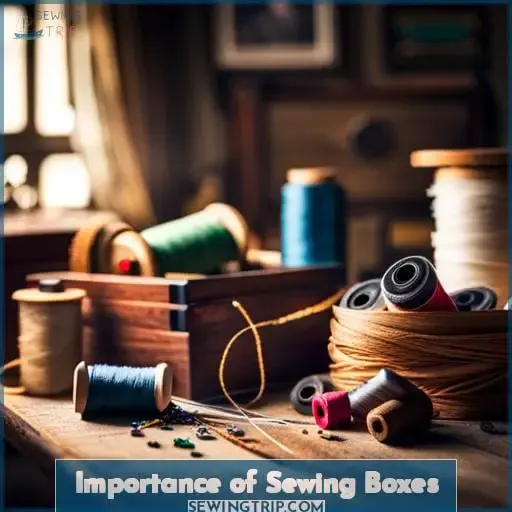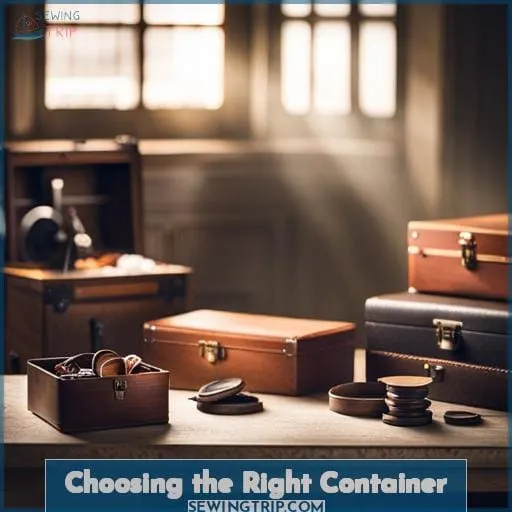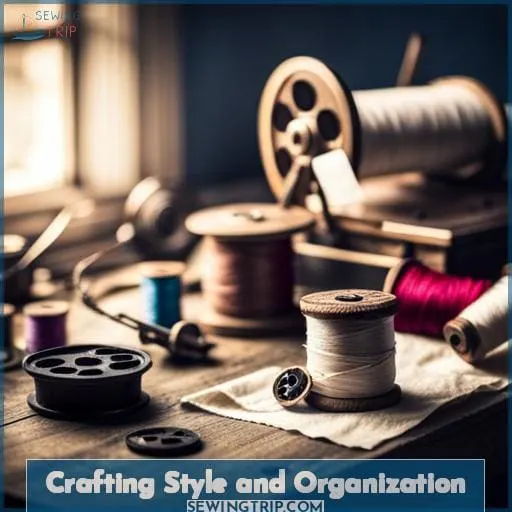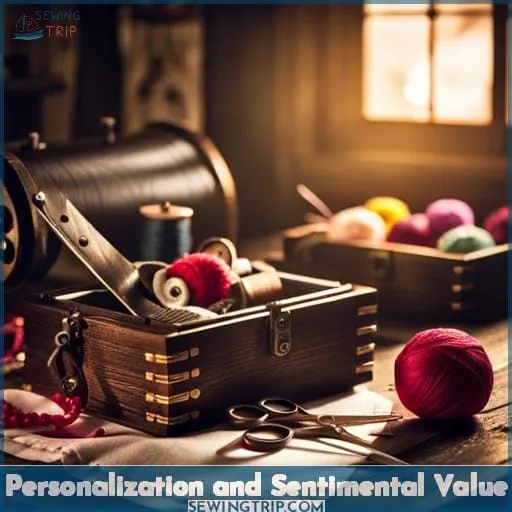This site is supported by our readers. We may earn a commission, at no cost to you, if you purchase through links.
 Discover the ultimate solution for organizing your sewing supplies with sewing boxes.
Discover the ultimate solution for organizing your sewing supplies with sewing boxes.
These handy kits are designed to keep all of your essential tools and materials in one convenient place, making it easy to find what you need when you need it.
From needles and thread to buttons and scissors, everything has its own designated spot.
With different styles and sizes available, there’s a sewing box that suits every craft enthusiast’s needs.
Say goodbye to cluttered workspaces and hello to organized creativity!
Table Of Contents
- Key Takeaways
- What is a Sewing Box?
- How to Use a Sewing Box?
- How to Organize a Sewing Box?
- Examples of Sewing Boxes
- Importance of Sewing Boxes
- Choosing the Right Container
- Crafting Style and Organization
- Sewing Boxes and Toolboxes Requiring Effective Organization
- Identifying Frequently Used Items for Easy Access
- Storing Less-used Items Out of the Way but Easily Accessible
- Considering Personal Craft Style for Organization Preferences
- Craft Style Influencing the Choice Between Neat Labeling or a More Accessible Layout
- Personalization and Sentimental Value
- Frequently Asked Questions (FAQs)
- Conclusion
Key Takeaways
- Sewing boxes are versatile storage solutions for sewing and crafting supplies.
- They are essential for organization and easy access to materials.
- Sewing boxes come in various shapes, styles, and sizes to cater to individual preferences.
- They are important for travel as they provide organized and easily accessible supplies on the go.
What is a Sewing Box?
A sewing box is a versatile storage container that allows you to easily organize and access your sewing and crafting supplies. It’s an essential tool for any sewing enthusiast, offering creative storage solutions and DIY organization tips for keeping all of your materials in one place.
With a variety of shapes, styles, and sizes available, sewing boxes cater to individual preferences while providing compartments specifically designed for carrying tiny items like needles, buttons, thread.
They’re also ideal for quilters or large-scale projects that require ample space to store fabrics and tools.
Whether you prefer vintage treasures or modern designs with customizable features, a sewing box serves as the perfect personalized crafting space where liberation meets mastery over your craft.
How to Use a Sewing Box?
Now that you have your sewing box, let’s talk about how to use it effectively.
First, conducting an inventory check is essential to ensure you have all the necessary supplies for your projects.
Next, make sure to include basic items such as scissors and measuring tape in your box so that they’re always on hand for quick repairs.
Lastly, choosing the right sewing box with compartments and storage options will help keep everything organized and easily accessible.
Inventory Check
First, take a moment to conduct an inventory check of your sewing box. This simple step is crucial for staying organized and prepared for any sewing project.
- Ensure you have all the necessary supplies for on-the-go repairs.
- Implement effective thread storage techniques to prevent tangles and confusion.
- Personalize your organization by incorporating vintage treasures like buttons or trims from thrift store makeovers.
Basic Items Included
Now that you have conducted an inventory check, let’s explore what basic items are typically included in a sewing box and how to use them.
Restocking essentials for on-the-go repairs include tiny scissors, safety pins, measuring tape, etc.
Utilize remnants of thread spools for efficient stocking.
Choose the right sewing box to efficiently store your sewing materials, whether it be a tackle box or vintage wooden sewing box.
Choosing the Right Sewing Box
To effectively use a sewing box, it’s important to choose the right one for your needs and preferences.
Consider container options that offer:
- Organization techniques
- Personalized touches
- Efficient stocking
- Strategic arrangement
Find a sewing box that suits your crafting style and allows you to master the art of organizing your supplies.
How to Organize a Sewing Box?
Now that you have your sewing box ready, it’s time to organize it for easy access to your supplies.
Start by focusing on thread storage, ensuring that you have a designated space or container for all of your spools and bobbins.
Next, consider how to store larger items such as scissors and rotary cutters – a craft caddy can be a great solution.
Finally, implement some organizational tips like adding frequently used items to containers and discarding unnecessary ones.
By organizing your sewing box effectively, you’ll be able to find exactly what you need when inspiration strikes.
Thread Storage
When organizing your sewing box, ensure proper thread care by effectively storing and organizing your thread for easy access.
Consider craft caddy solutions or designated boxes for efficient stocking.
Personalize the organization of your box to suit your craft style.
Don’t forget cleaning and painting tips to turn your sewing box into a stylish decor piece!
Storage for Larger Items
For organizing your sewing box, consider storage options for larger items like scissors and rotary cutters.
Here are some ideas for storage:
- Crafty toolboxes with compartments designed specifically for sewing supplies
- Utilizing sentimental storage solutions, such as vintage containers or repurposed boxes
- Incorporating painting techniques to customize the exterior of your sewing box
- Cleaning and sealing your chosen storage container to ensure durability
With these tips in mind, you can create a well-organized space for all of your larger sewing items while adding a touch of personal style.
Organizational Tips
For efficient organization, prioritize adding frequently used items to containers within your sewing box.
Utilize zip-lock bags for loose items and discard unnecessary ones.
Incorporate personal touches like laminated measuring bookmarks or classic vintage labels min transfer set.
Keep your sewing box clean with terrycloth applicator pads and use proper cleaning techniques before applying paint or transfer artistry.
Examples of Sewing Boxes
When it comes to sewing boxes, there are several examples that cater to individual preferences and needs.
Some popular options include:
- Wooden sewing boxes
- Vintage wooden 3-tier accordions
- Small sewing boxes
- Vintage sewing box trays
These different styles offer various compartments and storage solutions for organizing your supplies effectively. Choose the one that best suits your style of crafting and keeps everything easily accessible for your projects.
Wooden Sewing Box
Take a look at the versatility and charm of a wooden sewing box. Discover restoration techniques, customization ideas, DIY painting, and transfer applications for efficient cleaning and organizing.
Vintage Wooden 3-Tier Accordion
Check out the vintage wooden 3-tier accordion sewing box for a stylish and functional storage solution.
Its tiered design allows for easy organization of your sewing supplies with vintage charm.
Small Sewing Box
Looking for a compact sewing box that can still hold all your essentials?
Check out the small sewing boxes available on Etsy shops for convenient storage and organization of your sewing supplies and tools.
Vintage Sewing Box Tray
As you explore different examples of sewing boxes, one option to consider is a vintage sewing box tray. This unique piece offers restoration techniques, decorative elements, and DIY enhancements for customization options.
Various Styles Catering to Individual Preferences and Needs
When shopping for sewing boxes, you’ll frequently find various styles that cater to your individual preferences and needs.
From custom embellishments to creative configurations, there’s an option for everyone.
Importance of Sewing Boxes
When it comes to organizing your sewing supplies, sewing boxes play a crucial role.
They’re essential for keeping everything in one place and easily accessible, especially when you’re on the go.
Sewing boxes offer durability and cost-effectiveness, ensuring that your tools and materials are protected while providing convenient sizes for easy transportation.
With a well-organized sewing box, you can quickly find what you need when inspiration strikes or an urgent repair is needed.
Essential for Organized Travel With Necessary Supplies
Ensure you have an organized travel experience by utilizing sewing boxes to keep your necessary supplies easily accessible.
Portable solutions for on-the-go storage
Travel-friendly kits for mobile crafting
Compact organizers to organize essential supplies during travel
Durability and Cost-effectiveness
Are you looking for a sewing box that isn’t only functional but also durable and cost-effective? Sewing boxes offer:
- Material longevity
- Budget considerations
- Environmental impact awareness
- Design aesthetics preferences
- Repair options
Availability in Convenient Sizes for Easy Transportation
Sewing boxes come in a variety of sizes, allowing you to choose the one that best suits your needs for easy transportation and organization of your sewing supplies.
These travel-friendly sizes offer portable functionality and compact usability, making them convenient for easy transportability.
Facilitating Quick and Easy Access to Items for Sewing and Crafting Enthusiasts on the Go
When traveling or on the go, a sewing box becomes an essential companion for quick and easy access to all your sewing and crafting supplies. Portable crafting solutions like travel-friendly kits provide efficient accessibility and enhance crafting mobility for enthusiasts on the go.
Choosing the Right Container
When it comes to choosing the right container for your sewing supplies, there are a few factors to consider.
First, think about the average cost of sewing boxes which typically range from $10 to $25.
For more durable options, you can explore hardware or sporting goods sections where robust containers can be found.
Tackle boxes and toolboxes are also viable choices that offer cost-effectiveness and efficient organization for your sewing needs.
Average Cost of Sewing Boxes
You can typically find sewing boxes at an average cost of $10 to $25, offering a range of options for organizing your supplies.
Consider:
- Material quality
- Customization options
- Brand diversity
- User reviews
Consider Hardware or Sporting Goods Sections for Robust Options
For more robust options, consider checking out the hardware or sporting goods sections when choosing the right container for your sewing supplies.
Explore alternative containers, DIY adaptations, and custom accessories for travel solutions and unique materials.
Tackle Boxes and Toolboxes as Viable Choices
Consider exploring the hardware or sporting goods sections for robust options when choosing the right container for your sewing box.
Tackle boxes and toolboxes offer:
- Durability
- Portability
- Customization options
- Interior layout choices
- Maintenance tips
Plano Tackle Box as an Example
Continuing with our exploration of viable choices for organizing your sewing supplies, let’s take a closer look at the Plano Tackle Box as an example. Discover its versatility and customization tips for material compatibility, space optimization, and functional compartments.
Toolboxes as Cost-effective and Efficient for Organization
When choosing the right container for organizing your sewing supplies, opt for a toolbox that’s cost-effective and efficient.
Toolbox efficiency ensures budget-friendly storage and craft style harmony in your personalized crafting space.
Crafting Style and Organization
When it comes to organizing your sewing supplies, crafting style and organization go hand in hand.
As a sewing enthusiast, it’s important to consider how you prefer to work and access your materials. Whether you lean towards neat labeling or a more accessible layout, finding the right balance will help streamline your creativity and make every crafting session a breeze.
Sewing Boxes and Toolboxes Requiring Effective Organization
To effectively organize your sewing box or toolbox, prioritize identifying frequently used items for easy access.
Efficient arrangement and personalized touches can enhance organization in both sewing boxes and toolboxes.
Identifying Frequently Used Items for Easy Access
To effectively organize your sewing box, start by identifying the frequently used items for quick retrieval and efficient access.
Consider organizational strategies and an accessible arrangement for easy access to supplies.
Storing Less-used Items Out of the Way but Easily Accessible
To effectively organize your sewing box, store less-used items in a way that keeps them:
- Easily accessible
- Out of the way
for efficient organization and convenient accessibility.
Considering Personal Craft Style for Organization Preferences
Consider your own personal craft style when organizing your sewing box for optimal efficiency and accessibility.
Create organization harmony with an accessible layout and add personal touches for sentimental storage.
Craft Style Influencing the Choice Between Neat Labeling or a More Accessible Layout
For easy access to your sewing supplies, consider how your crafting style influences the choice between neatly labeled sections or a more accessible layout.
Crafting Preferences:
- Tailor organization styles to suit individual craft preferences.
- Decide between labeling sections for precise organization or creating an intuitive arrangement without labels.
- Balance ease of access with organizational aesthetics by choosing a layout that suits your crafting style and needs.
When it comes to organizing your sewing box, there are different approaches you can take based on personal preferences and crafting style. Consider whether neat labeling or a more accessible layout would better suit your needs.
Crafting Preferences:
Your unique way of approaching crafts plays a significant role in determining how you want to organize and store your supplies in the sewing box. Some crafters prefer everything neatly labeled, making it easier for them to find specific items when they need them during their projects (1). On the other hand, some crafters prioritize accessibility over precision labeling (2).
Labeling Techniques:
- Neatly labeled sections allow for quick identification of specific items at first glance (1).
- This method works well if you have many different types of supplies that require clear categorization and separation within the box’s compartments.
Accessibility Choices:
- A more accessible layout focuses on arranging items intuitively rather than relying heavily on labels (2).
- Crafters who choose this approach often group similar tools together while keeping frequently used ones easily reachable without having to search through specifically designated areas.
Personalized Arrangements:
- Incorporating personalized arrangements into organizing techniques allows you even greater customization options based on what works best for you individually as both an artist and organizer(3) .
- You can experiment with combining both neat labeling methods along with strategically placed commonly used tools where they’re most convenient – all while maintaining overall aesthetics within any given space inside one’s storage unit.
By considering these factors such as crafting preferences, labeling techniques, accessibility choices, and personalized arrangements based on your craft style , you can create an organized sewing box that caters to your specific needs.
Whether you choose neatly labeled sections or a more accessible layout depends on what works best for you. Remember, the goal is to have easy access to your supplies so that you can focus on unleashing your creativity and mastering new projects with ease.
Personalization and Sentimental Value
When it comes to organizing your sewing box, don’t forget about personalization and sentimental value.
Safely storing and organizing vintage items can add a touch of nostalgia to your crafting space.
Consider adding personalized touches like laminated measuring bookmarks or preserving family history with reminders of past generations.
Don’t underestimate the sentimental value that old buttons, scissors, and other vintage items can bring to your sewing experience.
Safely Storing and Organizing Vintage Items
Are you wondering how to safely store and organize your vintage sewing items in your sewing box? Ensure their preservation by:
- Cleaning
- Painting
- Sanding
- Applying transfers
- Sealing
Before reassembly, utilize White Lightning for cleaning and Rustoleum satin white spray paint for a fresh look.
Adding Personalized Items Like Laminated Measuring Bookmarks
As you personalize your sewing box, add laminated measuring bookmarks for a sentimental touch. These practical tools not only enhance your crafting experience but also preserve family history and evoke fond memories.
Get creative with DIY personalization and custom craft enhancements. Utilize measuring tools tips to make these laminated bookmark ideas truly special.
Preserving Family History With Reminders of Past Generations
Preserve your family history and add a personal touch to your sewing box with vintage reminders of past generations.
Incorporate sentimental artifacts and ancestral keepsakes to create a meaningful connection to your family legacy.
Enjoying the Sentimental Value of Old Buttons, Scissors, and Vintage Items
Embrace the sentimental value of your sewing supplies by cherishing old buttons, scissors, and vintage items. These nostalgic notions hold a timeless textile charm that connects you to the craftsmanship of previous generations and transforms them into treasured family heirlooms.
Frequently Asked Questions (FAQs)
Where can I find unique and stylish sewing boxes?
Looking for unique and stylish sewing boxes?
Check out specialty craft stores, online marketplaces, and even antique shops.
Explore different shapes, materials, and designs to find the perfect sewing box that reflects your personal style and enhances your creative space.
How do I clean and maintain a sewing box?
To clean and maintain your sewing box,
- Use White Lightning degreaser for a thorough wipe down.
- Apply Silk Mineral Paint for a fresh interior look.
- Sand surfaces with 220 grit sandpaper to smooth out imperfections.
- Finally, seal with Clear Coat and reassemble the box.
Can a sewing box be used for other crafts besides sewing?
Expand your creative horizons with a sewing box that doubles as a versatile craft companion.
From jewelry making to scrapbooking, embrace the power of organization and unleash your mastery across various crafts.
Are there specialized sewing boxes for specific types of sewing projects?
Specialized sewing boxes are available for various types of projects, such as quilting and large sewing projects. These boxes come in different shapes, styles, and sizes to cater to your specific needs and ensure organization while mastering your craft.
What are some tips for maximizing storage space in a sewing box?
To maximize storage space in your sewing box, consider arranging items based on frequency of use.
- Place commonly used tools at the top for easy access.
- Place less-used items towards the bottom.
Prioritize functionality and efficiency to enhance your crafting experience.
Conclusion
To sum it all up, sewing boxes are the ultimate solution for organizing your sewing supplies.
With designated spots for all your essential tools and materials, these handy kits make it easy to find what you need when you need it.
Whether you’re a seasoned craft enthusiast or just starting out, there’s a sewing box that suits your needs.
Say goodbye to cluttered workspaces and hello to organized creativity with sewing boxes!

